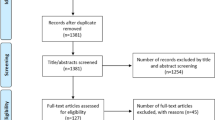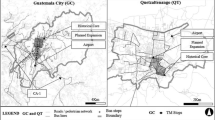Abstract
Approaches to calculating spatial accessibility within existing indices of multiple deprivation (IMD) methodologies are based on ‘traditional’ accessibility metrics and tend not to adopt more recent methodological enhancements. In particular, the last decade has seen a relatively large body of studies that have applied floating catchment area (FCA) methods that account for both service supply and potential demand interactions, mediated by the impact of distance, in a wide range of application areas. In this paper, we investigate potential implications of incorporating an FCA-based approach to measuring spatial accessibility within an existing IMD framework. Using the Welsh Index of Multiple Deprivation (WIMD) as a case study, FCA-derived accessibility scores were substituted for the existing approach used to calculate accessibility and a revised index was computed. The published methodologies used to construct the other ‘domains’ within the WIMD were followed and the implications for the overall deprivation measure were assessed. Statistical and visualisation tools revealed implications for both the access and overall IMD rankings, with sparsely populated (predominantly rural) areas tending to receive higher accessibility scores from FCA-based approaches than more densely populated (predominantly urban) areas. These areas in turn showed the greatest decline in ranking on the WIMD calculations following the application of FCA approaches. Potential reasons for such trends are posited before we conclude by drawing attention to the implications of adopting FCA-based approaches to calculate IMDs particularly for those policies designed to distribute funds or allocate resources to areas of need.





Similar content being viewed by others
References
Beynon, C. (2016) Risk factors associated with childhood obesity in Wales: a secondary analysis of cross-sectional data from the Welsh Health Survey. The Lancet. 388:S24.
Brunsdon, C., & Singleton, A. (2015). Reproducible research: concepts, techniques and issues. In C. Brunsdon & A. Singleton (Eds.), Geocomputation: A practical primer (pp. 254–264). London: Sage.
Caranci, N., Biggeri, A., Grisotto, L., Pacelli, B., Spadea, T., & Costa, G. (2010). The Italian deprivation index at census block level: definition, description and association with general mortality. Epidemiologia e Prevenzione, 34, 167–176.
Carstairs, V., & Morris, R. (1989). Deprivation: explaining differences in mortality between Scotland and England and Wales. BMJ, 299, 886.
Corder, G. W., & Foreman, D. I. (2014). Nonparametric statistics: A step-by-step approach (2nd ed.). Oxford, UK: Wiley.
Cummins, S., McKay, L., and Macintyre, S. (2005). McDonald's restuarants and neighbourhood deprivation in Scotland and England. American Journal of Preventative Medicine. 29(4):308–310.
Deas, I., Robson, B., Wong, C., & Bradford, M. (2003). Measuring neighbourhood deprivation: a critique of the index of multiple deprivation. Environment and Planning. C, Government & Policy, 21(6), 883–903.
Department for Communities and Local Government [DCLG]. (2015a). The English Indices of Deprivation 2015. https://www.gov.uk/government/uploads/system/uploads/attachment_data/file/465791/English_Indices_of_Deprivation_2015_-_Statistical_Release.pdf. Accessed 14 May 2017.
Department for Communities and Local Government [DCLG]. (2015b). English Indices of Deprivation 2015 Technical Report. https://www.gov.uk/government/uploads/system/uploads/attachment_data/file/464485/English_Indices_of_Deprivation_2015_-_Technical-Report.pdf. Accessed 14 May 2017.
Department for Environment Food and Rural Affairs. (2016). Guide to applying the Rural Urban Classification to data. Office for National Statistics. https://www.gov.uk/government/uploads/system/uploads/attachment_data/file/539241/Guide_to_applying_the_rural_urban_classification_to_data.pdf. Accessed 27 May 2017.
Department of the Environment, Transport and the Regions [DTER]. (1998). 1998 Index of Local Deprivation - A Summary of Results. http://imd.ocsi.co.uk/wpcontent/uploads/2015/09/1998-ILD-resultssummary.pdf. Accessed 3 May 2017.
Department of the Environment, Transport and the Regions [DTER]. (2000). Indices of deprivation 2000. http://webarchive.nationalarchives.gov.uk+/. http://www.communities.gov.uk/documents/citiesandregions/pdf/131306.pdf. Accessed 3 May 2017.
Environmental Systems Research Institute [ESRI]. (2015). ArcGIS desktop: Release 104. Redlands, CA: Environmental Systems Research Institute.
Exeter, D., Zhao, J., Crengle, S., Lee, A., & Browne, M. (2017). The New Zealand indices of multiple deprivation (IMD): A new suite of indicators for social and health research in Aotearoa, New Zealand. PLoS One, 12(8), e0181260.
Fairburn, J., Maier, W., & Braubach, M. (2016). Incorporating environmental justice into second generation indices of multiple deprivation: lessons from the UK and progress internationally. International Journal of Environmental Research and Public Health, 13, 750–763.
Ferguson, N., & Michaelson, M. (2013). The legacy of conflict - regional deprivation and school performance in Northern Ireland. Ruhr Economic Paper No.419. https://doi.org/10.2139/ssrn.2302666.
Fransen, K., Neutens, T., De Maeyer, P., & Deruyter, G. (2015). A computer-based two-step floating catchment area method for measuring spatial accessibility of day care centres. Health & Place, 32(1), 65–73.
Higgs, G. (2004). A literature review of the use of GIS-based measures of access to health care services. Health Services & Outcomes Research Methodology, 5(2), 119–139.
Higgs, G., Langford, M., & Norman, P. (2015). Accessibility to sport facilities in Wales: A GIS-based analysis of socio-economic variations in provision. Geoforum, 62, 105–120.
Hofmeister, C., Maier, W., Mielck, A., Stahl, L., Breckenkamp, J., & Razum, O. (2016). Regional deprivation in Germany: Nation-wide analysis of its association with mortality using the German index of multiple deprivation (GIMD). Gesundheitswesen, 78(1), 42–48.
Jarman, B. (1983). Identification of underprivileged areas. British Medical Journal (Clinical Research Edition), 286(6379), 1705–1709.
Jones, A., Hillsdon, M., & Coombes, E. (2009). Greenspace access, use, and physical activity: Understanding the effects of area deprivation. Preventative Medicine, 49(6), 500–505.
Langford, M., Fry, R., & Higgs, R. (2012). Measuring transit system accessibility using a modified two-step floating catchment area technique. International Journal of Geographical Information Science, 26(2), 193–214.
Langford, M., Higgs G., & Fry, R. (2015). “USW-FCA2: An ArcGIS add-In tool to compute Enhanced Two-Step Floating Catchment Area accessibility scores” Software Package–ArcMap add-in Available at: https://www.researchgate.net/publication/287198887_USWFCA2_An_ArcGIS_addIn_tool_to_compute_Enhanced_Two-Step_Floating_Catchment_Area_accessibility_scores. https://doi.org/10.13140/RG.2.1.3178.8884.
Langford, M., Higgs, G., and Fry, R. (2016). Multi-modal two-step floating catchment area analysis of primary health care accessibility. Health & Place. 38:70–81.
Luo, W. (2004). Using a GIS-based floating catchment area method to assess areas with shortage of physicians. Health & Place, 10, 1–11.
Luo, W., & Qi, Y. (2009). An enhanced two-step floating catchment area (E2SFCA) method for measuring spatial accessibility to primary care physicians. Health & Place, 15, 1100–1107.
Luo, W., & Wang, F. (2003). Measures of spatial accessibility to health care in a GIS environment: synthesis and a case study in the Chicago region. Environment and Planning B, 30(6), 865–884.
MacDonald, L., Cummins, S., and Macintyre, S. (2007). Neighbourhood fast food environment and area deprivation - substitution or concentration? Appetite. 49(1):251–254.
Macintyre, S., Macdonald, L., & Ellaway, A. (2008). Do poorer people have access to local resources and facilities? The distribution of local resources by area deprivation in Glasgow, Scotland. Social Science and Medicine, 67, 900–914.
Maier, W., Fairburn, J., & Mielck, A. (2012). Regional deprivation and mortality in Bavaria. Development of a community-based index of multiple deprivation. Gesundheitswesen, 74(7), 416–425.
Mao, L., & Nekorchuk, D. (2013). Measuring spatial accessibility to healthcare for populations with multiple transportation modes. Health & Place, 24, 115–122.
McGrail, M. R., & Humphreys, J. S. (2009). Measuring spatial accessibility to primary care in rural areas: Improving the effectiveness of the two-step floating catchment area method. Applied Geography, 29, 533–541.
Neutens, T. (2015). Accessibility, equity and health care: Review and research directions for transport geographers. Journal of Transport Geography, 43(1), 14–27.
Ngui, A. N., & Apparicio, P. (2011). Optimizing the two-step floating catchment area method for measuring spatial accessibility to medical clinics in Montreal. BMC Health Services Research, 11(1), 166–177.
NHS England. (2016) Technical Guide to Allocation Formulae and Pace of Change - For 2016/17 to 2020/21 revenue allocations to Clinical Commissioning Groups and commissioning areas. https://www.england.nhs.uk/wp-content/uploads/2016/04/1-allctins-16-17-tech-guid-formulae.pdf. Accessed 16 June 2017.
Noble, M., Smith, G.A.N., Wright, G., Dibben, C., Lloyd, M., Penhale, B. (2000). Index of Multiple Deprivation for Wales – Final Report. http://gov.wales/docs/statistics/2011/110831wimd2000en.pdf. Accessed 3 May 2017.
Noble, M., Wright, G., Smith, G., & Dibben, C. (2006). Measuring multiple deprivation at the small-area level. Environment and Planning A, 38, 169–185.
Noble, M., Barnes, H., Wright, G., & Roberts, B. (2010). Small area indices of multiple deprivation in South Africa. Social Indicators Research, 95, 281–297.
Northern Ireland Statistics and Research Agency [NISRA]. (2010). Northern Ireland Multiple Deprivation Measure 2010. https://www.nisra.gov.uk/sites/nisra.gov.uk/files/publications/NIMDM_2010_Report_0.pdf. Accessed 12 May 2017.
Northern Ireland Statistics and Research Agency [NISRA]. (2016). Consultation Document – Proposals for the updated NI Multiple Deprivation Measure (NIMDM 2017). https://www.nisra.gov.uk/sites/nisra.gov.uk/files/publications/NIMDM17-consultation_0.pdf. Accessed 12 May 2017.
O’Flaherty, M., Bishop, J., Redpath, A., McLaughlin, T., Murphy, D., Chalmers, J., et al. (2009). Coronary heart disease mortality among young adults in Scotland in relation to social inequalities: Time trend study. BMJ, b2613, 339.
Ordnance Survey. (2015). OS MasterMap Integrated Transport Network Layer. http://www.ordnancesurvey.co.uk/business-and-government/products/itn-layer.html. Accessed 21 May 2015.
Pickrell, W., Lacey, A., Bodger, O., Demmler, J., Thomas, R., Lyons, R., Smith, P., Rees, M., and Kerr, M. (2015) Epilepsy and deprivation, a data linkage study. Epilepsia. 56:585–591.
R Core Team. (2017). R: A language and environment for statistical computing. Vienna, Austria: R Foundation for Statistical Computing https://www.R-project.org/.
Sanchez-Cantalejo, C., Ocana-Riola, R., & Fernández-Ajuria, A. (2008). Deprivation index for small areas in Spain. Social Indicators Research, 89(2), 259–273.
Scott-Pillai, R., Spence, D., Cardwell, C., Hunter, A., and Holmes, V. (2013). The impact of body mass index on maternal and neonatal outcomes: a retrospective study in a UK obstetric population, 2004-2011. BJOG. 120(8):932–939.
Scottish Government. (2016a). Introducing The Scottish Index of Multiple Deprivation 2016. http://www.gov.scot/Resource/0050/00504809.pdf. Accessed 15 May 2017.
Scottish Government. (2016b). The Scottish Index of Multiple Deprivation: SIMD16 Technical Notes. http://www.gov.scot/Resource/0050/00504822.pdf. Accessed 15 May 2017.
Stephens, M., Evans, M., Ilham, M., Marsden, A., and Asderakis, A. (2010) The influence of socioeconomic deprivation on outcomes following renal transplantation in the United Kingdom. American Journal of Transplantation. 10(7):1605–1612.
Townsend, P. (1987). Deprivation. Journal of Social Policy, 16(2), 125–146.
Tseliou, F., Maguire, A., and Donnelly, M. (2016). The influence of mobility on mental health status in young people: the role of area-level deprivation. Health & Place. 42:96–103.
Wang, F. (2012). Measurement, optimization and impact of healthcare accessibility: A methodological review. Annals of the Association of American Geographers, 102(5), 1104–1112.
Welsh Government. (2005). Welsh Index of Multiple Deprivation 2005 – Technical Report. http://gov.wales/docs/statistics/2005/050930wimd2005technicalen.pdf. Accessed 12 May 2017.
Welsh Government. (2013a). Communities first - Programme Guidance 2013. http://gov.wales/docs/dsjlg/publications/comm/130905cfprogrammeguidance13en.pdf. Accessed 5 June 2017.
Welsh Government. (2013b). Consultation Document – Proposed indicators for the Welsh Index of Multiple Deprivation 2014. https://consultations.gov.wales/sites/default/files/consultation-documents/131128-proposed-indicators-wimd-2014-en.pdf. Accessed 1 June 2017.
Welsh Government. (2014a). Welsh Index of Multiple Deprivation (WIMD) 2014 Revised. http://gov.wales/docs/statistics/2015/150812-wimd-2014-revised-en.pdf. Accessed 2 May 2017.
Welsh Government. (2014b). Welsh Index of Multiple Deprivation 2014 (WIMD 2014) Technical Report. http://gov.wales/docs/statistics/2014/141218-wimd-2014-technical-en.pdf. Accessed 2 May 2017.
Welsh Government (2015). Welsh Index of Multiple Deprivation 2014: A guide to analysing deprivation in rural areas – Revised. http://gov.wales/docs/statistics/2015/150812-wimd-2014-guide-analysing-deprivation-rural-areas-revised-en.pdf. Accessed 1 June 2017.
Whynes, D. K., Frew, E. J., Manghan, C. M., Scholefield, J. H., & Hardcastle, J. D. (2003). Colorectal cancer, screening and survival: the influence of socio-economic deprivation. Public Health, 117(6), 389–395.
Whyte, L. A., Kotecha, S., Watkins, W. J., & Jenkins, H. R. (2014). Coeliac disease is more common in children with high socio-economic status. Acta Paediatrica, 103(3), 289–294.
Acknowledgments
This paper is based on research supported by the Wales Institute of Social and Economic Research, Data and Methods (WISERD). Funded by the Economic and Social Research Council (ESRC), WISERD is a collaborative venture between the Universities of Aberystwyth, Bangor, Cardiff, South Wales and Swansea (Grant number: ES/L009099/1).
Author information
Authors and Affiliations
Corresponding author
Ethics declarations
Conflict of Interest
None declared.
Electronic supplementary material
Rights and permissions
About this article
Cite this article
Page, N., Langford, M. & Higgs, G. Measuring Spatial Accessibility to Services within Indices of Multiple Deprivation: Implications of Applying an Enhanced two-Step Floating Catchment Area (E2SFCA) Approach. Appl. Spatial Analysis 12, 321–348 (2019). https://doi.org/10.1007/s12061-017-9246-2
Received:
Accepted:
Published:
Issue Date:
DOI: https://doi.org/10.1007/s12061-017-9246-2




